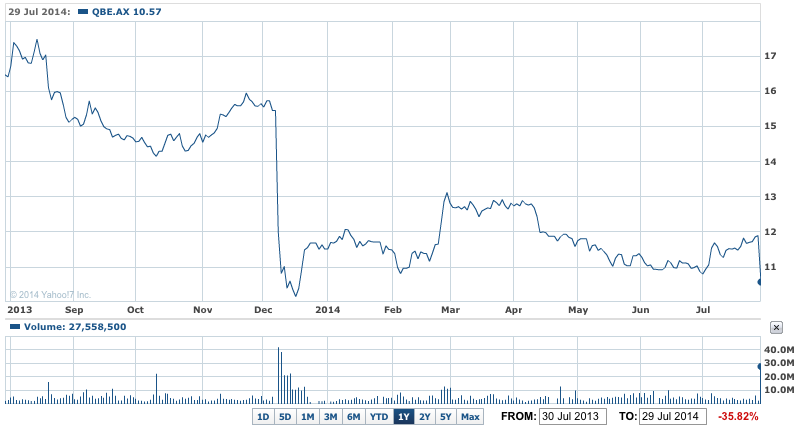What’s an Australian corporate profit reporting season without an earnings downgrade from QBE?
Up to yesterday it was looking as though we might have survived the June 30 reporting period without some bad news from the country’s biggest global insurer.
But QBE upped and released yet another downgrade yesterday morning, the second in seven months, thereby giving the reporting season its usual dose of bad news from the company.
Yesterday’s earnings downgrade followed one last December, ahead of the insurer’s full year profit report in February (and there were earlier downgrades such as 2013, 2012 and 2011).
And, as usual, after yesterday’s news was released to the market, investors threw their hands up and sold QBE shares, which fell more than 14% at one before ending down 11% at $10.58.
Large as that was, it wasn’t anywhere near December’s share price – from more than $16 a share to a low of just over $10 .
Such was the surprise at yesterday’s downgrade, that QBE’s board and management can consider themselves lucky they didn’t cop an even bigger hiding from disgruntled investors.
QBE 1Y – QBE keeps faith and downgrades earnings, again

And there could be more shocks ahead as this downgrade relates to increased reserving at its Argentina’s workers compensation business. (Like many investors I didn’t realise QBE was in that business in Argentina.)
If things go badly, QBE could have another headache in Argentina in the next day or so.
The country could default on its foreign debts tonight or tomorrow. If that happens the economy would plunge into a nasty recession which would mean rising losses for foreign investors such as QBE.
Argentina has until the close of business tonight (US time) to either do a deal with some foreign investors in some of its bonds, get more time to talk, or decide to default.
It’s up in the air.
QBE said yesterday that its first half net profit is now expected to be around $390 million, down from the $477 million posted in the first half of fiscal 2013.
The reason is the problems in the company’s small Latin America division. It’s one of the smallest business units in QBE, but has needed a $170 million boost to its reserves.
QBE has also been hit by higher than expected large individual risk claims.
As a result, the group’s combined operating ratio for the first half has now crept up to the 96%-97% instead of the previous forecast of 93%.
Therefore QBE now expects to book an insurance profit margin of 7% to 8% for the first half, compared with consensus expectations of around 10%.
And revenues will be weak as well in the first half.
The company said its gross written premium income is expected to be around $8.5 billion for the half, below the company’s $8.9 billion budget.
“Market conditions globally are proving to be more competitive than previously anticipated.
"QBE remains committed to disciplined and technical underwriting and we have not hesitated to walk away from pricing that does not meet our minimum risk based return hurdles,” the group said in a statement.
That means QBE has been refusing to cut premiums to hold onto or attract new customers. It’s trying to protect its insurance margins, which was one positive for investors and analysts.
The company said its other portfolios were otherwise performing “broadly in line with internal plans”.
QBE said its troublesome North America division generated an underwriting profit and the combined operating ratio has improved compared with 2013.
At the close yesterday QBE shares had fallen by more than 37% in the past 12 months, while the market was up by just over 10%.
And so far as dividends are concerned, QBE management told analysts yesterday that they will wait until close to the earnings statement on August 19 to reveal the size of the payout.
They said the company is maintaining its previous commitment to pay up to 50% of cash profits as dividends (which, if you remember, was a cut from the previous level of 60% or more).













